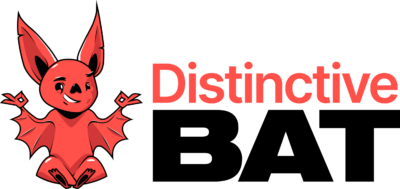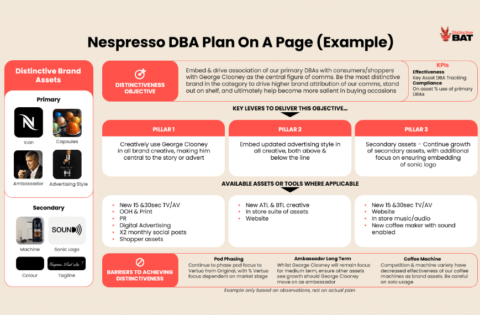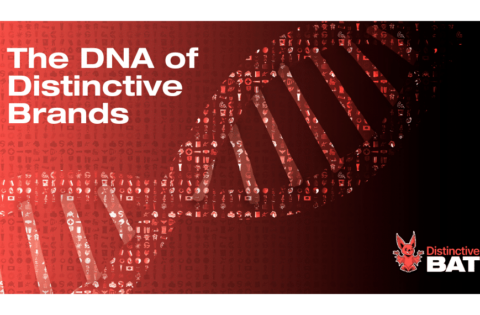
Exploring Various Market Research Methods: A Comprehensive Guide
Exploring Various Market Research Methods: A Comprehensive Guide
Market research (or brand research) helps with the creation, development, and ongoing management of brands, enabling you to make informed, insight led decisions that drive growth.
Taking many forms and applications, we have summarised here just some types of market research available to you, with an aim of helping guide you on the best type of market research based on your needs and objectives. There isn’t a one size fits all approach and, in practice, it’s about choosing the right research methodologies for your specific needs and objectives.
Whilst you are likely to be monitoring key brand health metrics consistently over time, other research undertaken will be driven by brand life stage, market conditions and business objectives.
(TRADITIONAL) CONSUMER UNDERSTANDING
Focus Groups
The gathering of small groups of target audience members for in-depth discussions provides a far deeper understanding of behaviour than can be obtained from survey data points.
Focus groups allow participants to elaborate on their responses, revealing emotions, beliefs, and cultural contexts that cannot be captured quantitatively. The approach seeks to understand not only what people are thinking, but why.
Two common applications of focus groups are before and after quantitative research. The former helps researchers refine their hypotheses and develop more targeted survey questions. The latter deepens understanding of a quantitative study output and provides the “why?” behind the numbers.
Key to successful focus groups are experienced facilitators who can extract pertinent insight from the conversations and spontaneous responses, by asking insightful questions that elicit rich and meaningful data.
Ethnographic Research (or Consumer immersion)
Ethnography observes life as it happens instead of trying to recreate or recall behaviour in an interview setting. Typically one-on-one, ethnography will observe or interview a participant in their environment, usually their home, where they will be more open and honest.
The methodology aims to get to the root of why people do what they do versus what they say they do. It is well suited to understand motivations and decision-making processes that are too complex for quantitative research methods. Ethnography is also well-placed to understand unmet needs and pain points in the customer and consumer experience through real life observations.
With this deep understanding, you can tailor products, services, and marketing messages to better meet consumer needs as well as identify opportunities for product development and innovation from uncovering unmet needs.
Famously, it was consumer immersions conducted by beauty brand Dove, that found that the majority of women did not consider themselves beautiful and led to their successful Real Beauty campaign. A good example of the benefits of market research.

BRAND PLANNING
Market Segmentation Research
Segmentation research divides your market into consumer groups based on characteristics such as age, gender, location, attitudes, purchase, and usage behaviour. The variables used will be selected as part of the study and informed by category buying and usage behaviours.
Segmenting your market enables you to identify target growth segments for your brand and, equally important, who you do not want to target.
Defining your target segments will allow you to create targeted marketing campaigns that really resonate with consumers and maximise the effectiveness of your marketing spend. Market segmentations can also be helpful in the development of portfolio strategies and the allocation of business resources.
The key to an effective segmentation model is your ability to apply it in practice. Is there a significant enough difference between segment needs to warrant different creatives? Can your media agency differentiate between segments with different buying plans?
Distinctive Brand Asset Research
Distinctive Brand Assets (or brand codes) are learned associations that help us to notice, recognise, remember and recall a brand. These might be symbols, icons, characters, audio, ad styles, fonts and / or colours. Distinctive Brand Assets are a critical marketing effectiveness lever, but very few brands research them.
Distinctive Brand Asset research measures the performance of your own and competitor brand assets. The research will allow you to make data-led decisions in areas which are often subjective. These include asset prioritisation – Which assets should you feature heavily on pack? Which are your best performing DBAs that you should invest in and build over time? – and communications development – Which assets will increase brand recall and marketing effectiveness? Which assets are being misattributed and prompting your competitors?
For more information on Distinctive Brand Asset research or tracking get in touch here, Distinctive BAT is a specialist in this area.

Distinctive Asset Measurement: Brand Research That Provokes Action
Used by some of the world’s most distinctive & leading brands






Customer Experience (CX)
Customer Experience (CX) is the culmination of interactions consumers have with your brand at all stages of the customer journey. Believed by some to be as important as the product and/or service itself, customer experience is a way of standing out from competitors and increasing consumer retention, satisfaction and sales.
CX research is the process of gathering and analysing data to understand and evaluate the interactions customers have with your brand throughout the customer journey. The goal of CX research is to gain insights to map the customer journey and understand consumer perceptions, needs, preferences and satisfaction within it. Ultimately you want to identify, measure and track the touchpoints that drive customer experience.
There are many methods of conducting CX research including surveys, interviews, focus groups and social listening. Qualitative research will typically provide in-depth CX insight that will enable you to map the consumer journey. Quantitative metrics will be used to identify and track your key CX performance indicators.
CX data points enable businesses to make insight-driven decisions to build stronger brand relationships and drive growth through exceptional experiences that deepen loyalty and provide more opportunities for people to interact with their brand.
Touchpoint Effectiveness
Your brand will have many interactions with consumers and potential consumers every day; an advert on social media, a recommendation from a friend, the product or service itself. But which are noticed? And, which have an impact on your brand performance?
Touchpoint Effectiveness research identifies the key touchpoints for your brand and the impact they have on buyers. Touchpoint effectiveness can look to distinguish between touchpoints that build brand equity and those that drive sales. (And identify those superstar touchpoints that do both!) The output provides an objective and holistic view – across sales and marketing touchpoints – to help brand owners prioritise touchpoints known to maximise the desired impact of their activities.
Most often, touchpoint effectiveness research involves a quantitative survey which will show respondents images of various brand touchpoints. The number of touchpoints you can include in a survey is an obvious limitation of the approach. (Far fewer than the number we encounter in the real world!). A survey approach will also only capture recalled brand touchpoints. More sophisticated methodologies can extract brand touchpoints from devise usage data, incorporating some of those that have been forgotten or consumed subconsciously.
Price Elasticity Research
The majority of price elasticity work – looking to understand the sensitivity of brand sales to changes in price – will be conducted through regression analysis of historic sales data. Also common is A/B testing online where you have tighter control of price and can more easily monitor the impact of a new price on demand. Whilst accurate, these approaches have their limitations and might not answer all your business questions.
Quantitative price elasticity research is not limited to historic data points and allows you to test future scenarios and hypotheses, such as the impact of yet to be launched innovation and price thresholds that have not been reached in the real world.
Quantitative surveys report claimed willingness to pay rather than actual sales but they are still helpful in understanding the likely impact on demand of price changes, pricing impact across different consumer segments and any expected switching between brands – potential share gain and loss.
Price Elasticity Research can help you manage risk by identifying key price points in the market which will have a significant impact on sales, identifying consumers who are more sensitive to price changes and understanding the optimal price position for your brand versus competitors to retain or grow market share.
Brand Code Meaning Research
Brand Code Meaning Research (Or Messaging Brand Assets) looks more at the meaning that is derived from certain brand assets. While closely related to Distinctive Brand Assets, here we look more at metrics related to differentiation and how a brand code supports brand positioning and builds associations with key brand values.
Brand Code Research can take various forms. Qualitative research allows you to probe your audience more deeply and can be a useful input when you are building your codes. Netflix used focus groups to research its sonic asset development. (The “Ta-Dum” was found to associate words like “dramatic”, “interesting”, “beginning” and “movie”.)
Quantitative surveys can also test the extent to which brand codes align with a brand’s positioning. Distinctive BAT offers a bolt on to Distinctive Brand Asset research that explicitly tests whether brand assets and imagery align with the intended brand strategy. Brand asset research itself can also guide the creation of brand codes by identifying and understanding the role of brand assets with your key audience.
You can read more on the differences between Distinctive Brand Assets and Messaging Brand Assets here, or get in touch to understand how we can help.
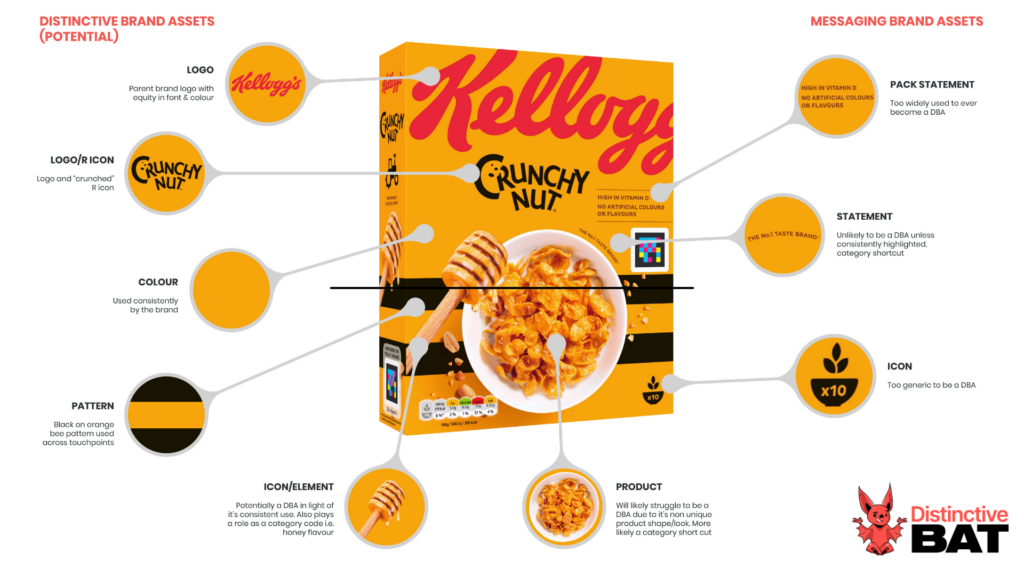
TESTING & EVALUATION
Ad Testing
Advertising research, distinct from advertising effectiveness research, tests your campaign creative before launch. With the amount of money invested into advertising and media spend, it makes sense to pre-test your ads to make sure they resonate with your target audience and drive the desired behaviour change. Research has shown that high-quality creative can drive more than four times as much profit as low-quality creative.
Collected from a quantitative survey, advertising research typically reports brand lift metrics such as awareness, consideration, and intent, alongside engagement and response metrics, such as trial or recommendation to others. This approach provides solid and objective metrics to aid creative development, but it is restricted to capturing our rationale, system 2 thinking.
Researchers are increasingly trying to tap into our system 1 thinking, the subconscious behaviour that drives more of our decision making, through the inclusion of neuromarketing techniques such as eye tracking, facial coding, brain activity monitoring (EEG) and the measurement of blood activity in the brain (fMRI).
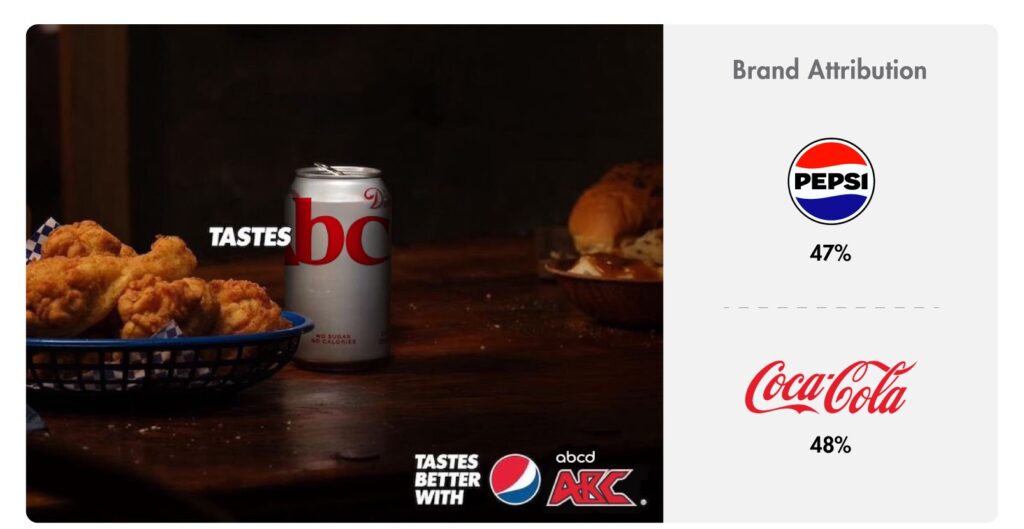
Product Concept Testing
95% of new products fail (source Clayton Christensen, professor, Harvard Business School) Concept testing is an early-stage research tool that allows you to validate product, design and marketing ideas before launch, guiding development and reducing the chances of failure. Concept testing gives you a detailed understanding of your target customer’s requirements and allows you to ensure that your product has the features they are looking for and will buy. Purchase intent testing within studies can help you understand how willing people are to pay your recommended price and provide guidance for forecast projections.
Methodologies vary depending on whether you want to test a single concept, obtain preferences from several concepts, or test a range product features in various combinations.
The DNA Of Distinctive Brands
Inspire your team and brand, by understanding how to achieve greater levels of distinctiveness with our guide to Distinctive Brand Assets
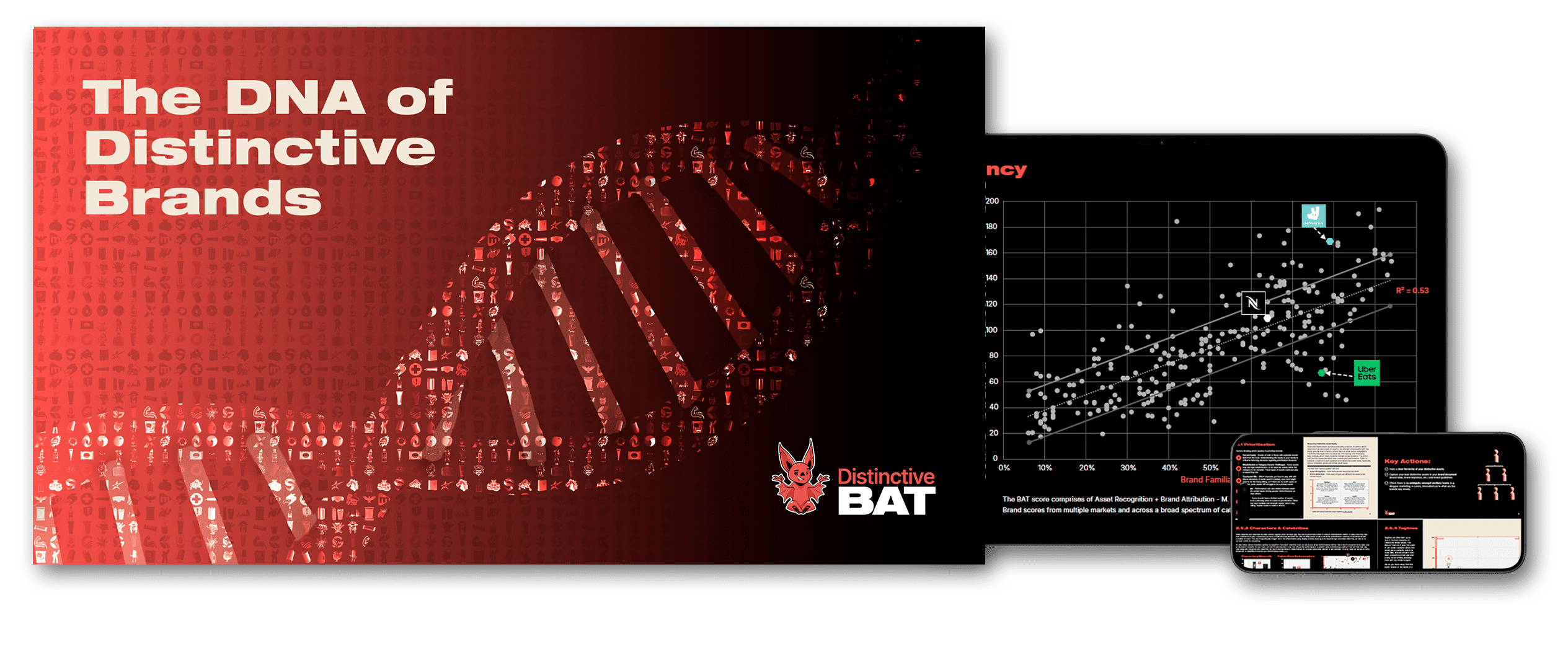
Packaging Research
A product’s packaging is typically the most seen brand touchpoint and so, rightly, is regarded as the face of a brand. Great packaging distinguishes your product from the competition and influences the purchase decision, ensuring your product makes it into the basket.
Designed to stand out, communicate meaningful benefits and brand values, packaging research helps brand owners understand how well their pack performs against these objectives. It also helps to find out what motivates people to select one product over another. Packaging insights can help increase pack stand out on shelf, prioritise on pack messaging, and understand the likely success of a new pack design.
Like other types of research, packaging research should consider the conscious, system 2, and subconscious, system 1, decision making, combining what consumers say they will do with what they actually do. There are various research methodologies, depending on your needs. Most look to test packaging in real-life environments, or simulated real-life environments, and seek to understand the impact of the pack on shopper behaviour.
Brand codes such as colour, shape and icons play a key role in pack design, and DBA research of your pack and key pack elements can be incredibly useful in understanding which assets are key to your pack, and inform how you can stand out on shelf. Contact us to find out more.
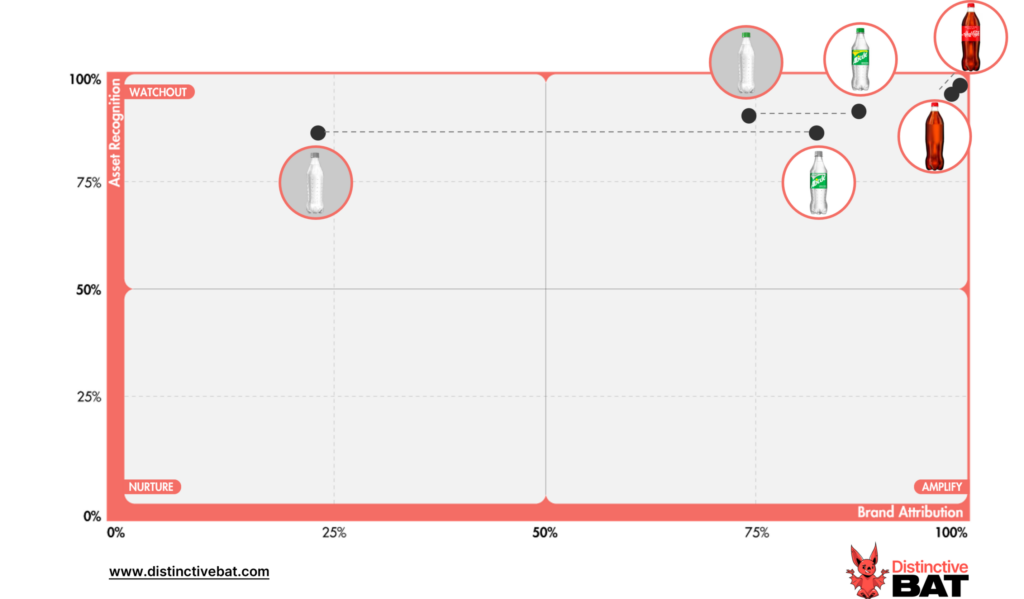
BRAND MONITORING
Brand Health Tracking
Brand Health Tracking is the measurement of your brand-building efforts against key metrics over time. Brand Health Tracking helps companies understand the impact of brand activities and provides data to make informed decisions to set the direction and targets for future growth.
Most often brand health trackers will comprise of brand funnel metrics – awareness, consideration, purchase and repurchase – as well as perceptions and brand equity. The data identifies strengths and weaknesses in brand strategies and benches brand performance against competitors.
The consistency of metrics over time is key to assess long-term trends and quantify brand performance over time against long-term brand goals.
Whilst Brand Health Tracking surveys can be extensive (and breadth of data is helpful to marketers refining their strategies), most companies will distil brand health trackers into a few key performance indicators. One of the strongest predictors of actual sales, spontaneous (or unaided) brand awareness is a key metric here.
Some BHTs are quite traditional in their approach to brand measurement, and thanks to the work of Jenni Romaniuk of the Ehrenberg-Bass Institute, there is a move towards measuring mental availability in context better via Category Entry Points.
Often certain metrics or questions can be forced into a Brand Health Tracker, this includes the measurement of distinctive assets, where respondents are primed with the brand name, ahead of the research, giving an inflated picture. Read more here about the common pitfalls of measuring DBAs in a BHT.
Social Listening
Social Listening monitors what people are saying about your brand on social media and the internet, helping you to better understand consumer behaviour, preferences, and trends.
Social Listening tracks mentions of your brand, the competition and industry to gain insights into brand sentiment, campaign effectiveness and trends. By understanding what people are saying about you online you can be reactive to the latest consumer sentiment, take action to protect your reputation and stay ahead of the competition.
Much of the data collection is automated through social media monitoring. This involves specifying the keywords, brands, hashtags, and other terms you want to track. You can also monitor specific social media platforms, websites, and forums. Output can be quantitative or qualitative, depending on what you are looking to track but you would expect key metrics to be presented on a dashboard for quick interpretation and analysis.
Social Listening is a great way to get an indicative read on brand sentiment and campaign impact. Just watch out for lower coverage of consumer segments who are less active online or the bias of some more open channels like Twitter/X.
If you are uncertain about the type of research you need, get in touch with Distinctive BAT and we can help advise.
Distinctive Asset Measurement: Brand Research That Provokes Action

Used by some of the world’s most distinctive & leading brands






